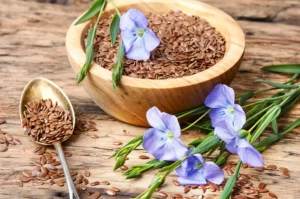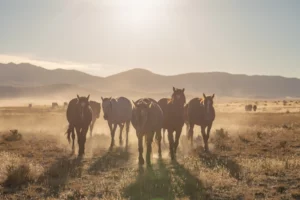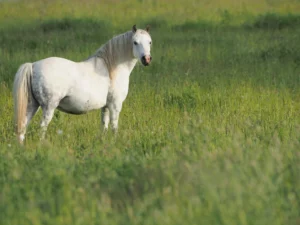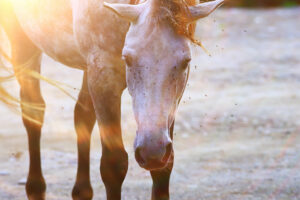Sufficient sleep is extremely important for our health. Anyone who has ever suffered from a temporary or permanent lack of sleep knows this. You no longer feel productive, are annoyed, find it harder to concentrate and become more susceptible to illness. This is nothing new for humans per se. We have more control over whether we improve our circumstances and sleep or continue to compensate for tiredness with coffee.
But what does it look like when our horses sleep?
The topic of sleep is often neglected. While horse owners tend to focus on training and education, behaviour, feeding and equipment, they are generally less aware of their horse’s sleeping behaviour. This may be due to the fact that we are generally in the stable for a few hours per day and everything that happens before and after is largely beyond our knowledge.
Research has not yet conducted extensive studies on sleep behaviours in horses. There have only been a few studies and the data on the horse’s need for sleep and total resting time varies considerably. This is mainly because the earlier studies were mainly based on observations. However, this meant that it was not possible to make a valid distinction between when the horse was merely resting and when it was actually sleeping, especially when standing up in a resting position. More recent studies on sleep behaviour were able to find this out more precisely thanks to mobile research equipment (Kalus 2014 + Fuchs 2017), but only focused on resting times during the night.
Do horses need less sleep than humans
What the results have in common is that horses sleep significantly less than humans and other mammals. The estimated total resting time per day is 5 – 9 hours. However, the horse does not sleep through this period in one continuous block but shows a polyphasic sleep pattern. This means that several waking and sleeping phases alternate over 24 hours. It must also be considered over the total duration that the horse predominantly dozes for shorter periods while standing and, in comparison, only sleeps deeply for a few hours while lying down or is in the REM sleep phase.
The duration of the individual sleep phases varies considerably. If an average is drawn from the results of the studies, the most frequently documented duration of a “sleep unit” can be averaged between 30 and 40 minutes. Continuous sleep phases, while laying down, lasting more than 60 minutes have been observed much less frequently in adult horses.
Not all sleep is the same
Different types of sleep take place during a sleep phase, which can be simplified into three different types:
- dozing/light sleep
- Deep sleep (also known as “slow wave sleep” or “SWS sleep”)
- REM-sleep
You will often find your horse dozing in the stable during the day, especially at times when there is little going on, for example during midday. The horse puts weight on one hind leg while the other one rests at an angle on the toe. The head is held at about withers height, the eyes are half-closed, and the lower lip usually hangs a little. This way of standing is fatigue-free for the horse, as it has a special structure in the muscles and tendons of the hind legs that provides a passive standing apparatus – the so-called ‘stance position’. This is an important feature for the flight animal horse, as it can recover by resting while standing, but can still flee from predators as quickly as possible if it is startled.
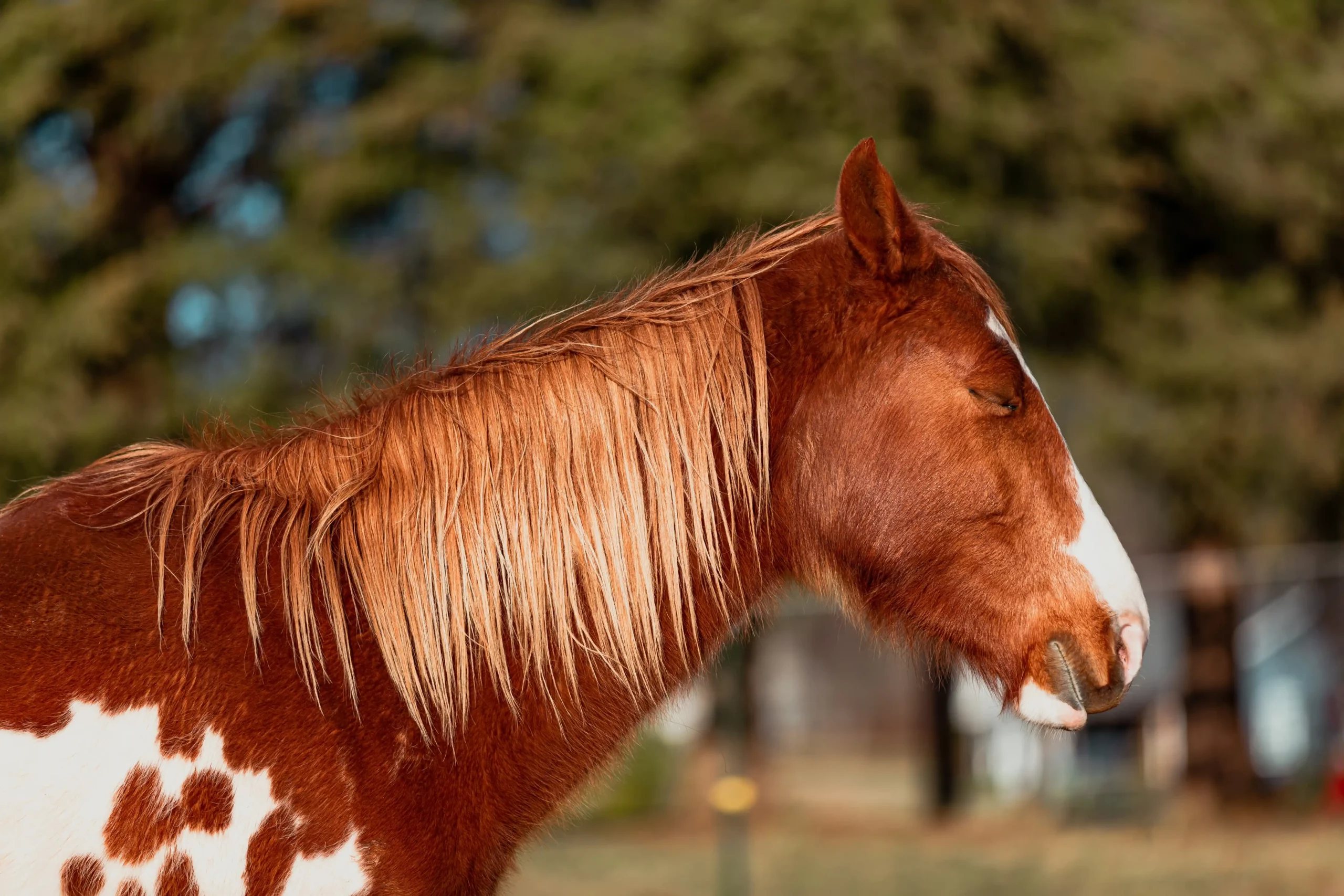
© Adobe Stock / Unique Stock Art
Horses need to lie down for a deep sleep
Deep sleep takes place preferably when lying down but should also be possible to a small extent when standing up.
The horse usually lies in the chest position for this. The head can be carried or lowered to or just before the ground. Deep sleep is the most intensive form of resting. Horses are barely aware of environmental influences during this time. Important metabolic processes, such as the rate of protein synthesis, are at their highest in this state. This sleep phase is of great importance for the body’s repair processes.
REM sleep takes place exclusively when lying down. The horse usually lies flat on its side, as it undergoes complete muscle relaxation during this sleep phase. REM is the abbreviation for Rapid Eye Movement, as it involves rapid and opposing eye movements. There is also increased brain activity.
REM sleep is an extremely important part of a horse’s sleep. It is currently assumed that the horse spends a total of around 30 minutes in REM sleep within 24 hours, provided it feels safe enough to lie down to sleep.
Main resting times
The horses usually lie down when the stable is quiet. Around midday or from midnight until the early hours of the morning are typical times when the horses lie down to sleep, usually with one or a few horses standing guard and dozing. After a while, they swap and the guards lie down to sleep, while “well-rested” herd members take over the watch.
The horses lie down up to 5 times between midnight and 4 am in particular. Overall, average lying times of 2-3.5 hours were observed. Approx. 65% of this time is spent in deep sleep and approx. 15% in the REM sleep phase. The remaining 20% is spent in light sleep.
Horses have a good sense of time and base their sleeping times on possible disturbances such as daily stable management tasks or training times. This means that routines times in regards to stable management are important to the horse, as they adjust their sleeping and resting times around the activities of humans.
It usually remains hidden for a long time when a horse suffers from a lack of sleep
The lack of deep and REM sleep can be compensated for to some extent for around one to two weeks at most. If the horse does not have the opportunity to spend at least 1.5 – 2 hours a day in deep sleep beyond this period, we are already talking about a lack of sleep, which has a negative effect on the horse’s health.
Loss of performance and fatigue can be caused by many different issues. However, you should become aware, when injuries on the front of the fetlock and/or carpal joints repeatedly occur unexplained. The wounds occur when horses are so tired that dozing turns into deep sleep and they collapse and hit the ground with their joints.
Don’t take ‘narcolepsy’ lightly
If you observe the horse buckling its forehand or even falling to the ground while dozing, this is a clear warning signal that the horse has been suffering from sleep deprivation for a long time, which is often referred to as “narcolepsy”, but has nothing to do with the disease of the same name in humans.
This is regularly caused by the fact that the horse no longer lies down sufficiently. It is therefore unable to reach the important deep sleep and, above all, REM sleep phase. The REM sleep phase is extremely important for horses. It has now been discovered that the symptoms of narcolepsy in horses are not genetic but are due to a lack of REM sleep.
At this point it is important to find out why the horse no longer lies down or doesn’t lie down long and frequently enough to get sufficient sleep.
Horses like soft beds too
An important basic requirement for the horse to lie down to sleep is not only a feeling of security, but above all a suitable lying area. This should be large, non-slip, covered, dry, clean, and well bedded. The horse should be able to lie down in the box without running the risk of getting cast. It has been found that horses lie down up to 30% less if the box size is smaller than legally required in relation to their body size.
According to the Animal Welfare Act, the stable size must be at least 2x the height of the horse measured at the withers squared. If we take a 1.70m tall avarage warmblood for example, the prescribed box size for its body size is therefore at least 11.56m², i.e. almost 12m2, which corresponds to a 3m x 4m box. Mind you, this is the minimum stable size! In terms of lying comfort, the more space, the better.
Lack of sleep in open stable groups is far more common
In a group environment in an open stable yard, the covered lying down area should be large enough so that all horses in the group can theoretically lie down at the same time with sufficient personal space. Groups tend to favour resting together at the same time. Some horses remain standing and doze or keep watch, while the others feel safe, can lie down and sleep. Who keeps watch and who sleeps alternates.
If the total lying down area is too small for all group members, the low-ranking horses have the disadvantage that they cannot find a suitable place to sleep in bad weather, for example, and therefore cannot lie down. A horse would not normally lie down in the mud to sleep, this only happens when they collapse from tiredness. This situation only arises out of desperation and is a big red alert signal!
Horses prefer straw to shavings in the lying down area, shavings to rubber mats or the bare floor. Rubber mats are softer than stone or wooden floors and are certainly a welcome innovation for the stable in terms of insulation from the cold floor. However, rubber mats in lying areas must always be used in conjunction with sufficiently clean and thick bedding on top to be truly comfortable for the horses. Hard surfaces are demonstrably avoided for lying down, including paved tracks, gravelled trails, or concreted stable areas. Sandy or grassy ground, on the other hand, invites horses to lie down, but only in dry conditions and not when the ground is wet.
Who is predisposed to sleep disorders?
Stress factors such as a change of stable, a stay in hospital, a change of stable neighbour, new horses in the group or a restless or poorly socialised group can severely disrupt sleeping behaviour.
Particularly with old and/or low-ranking horses, it is important to check whether they are still able to lie down regularly to sleep or whether they appear stressed in their current group environment.
Sleep deprivation is far more common in open stables than in individual boxes!
The solution for some low-ranking or old horses may be to allow them in a well-bedded box for the night, where they can eat and sleep in peace.
Sometimes the existing group is simply not suitable for the individual horse. If he is repeatedly shooed away from his food and resting place by the others, if he can hardly find a quiet corner to doze in, or if he is high in rank but takes his job too seriously and is overwhelmed by it, a change of group or overall management should be considered.
Physical pain when lying down and/or getting up can also be responsible for horses no longer wanting to lie down frequently. This is often a reason for lack of sleep, especially in older horses and those with arthritis. The cause should be investigated, and the pain addressed therapeutically.
So how does my horse sleep?
Sleep is an important factor for the horse’s mental and physical health. It is important that the horse can lie down to sleep in order to achieve the restorative deep sleep and REM sleep phases. These sleep phases are also essential for a well-functioning metabolism.
That’s why we should always focus on ensuring that our horses have good conditions in their current stable or track environment to fulfil their individual need for sleep. Unlike us humans, horses cannot help themselves in this situation, and therefore have to rely on their attentive owner to provide the most suitable arrangements.
Sources
Zeitler-Feicht, M.H. (2001): Durch Haltungssysteme Pferd. Pferdeland, Sonderausgabe bedingte Verhaltensstärungen beim (2. Pferdetag in Mecklenburg- Vorpommernl, 5-10
Zeitler-Feicht, M.H.; Muggenthaler, Haltung in Abhängigkeit K. (2013): Zum Liegeverhalten von Pferden in Gruppen von der Liegeplatzgestaltung Tierarzt 94(5) S. 420-428 und Rangord
Kalus, M. (2014): Schlafverhalten und Physiologie des Schlafes beim Pferd auf der Basis polysomnographischer Untersuchungen. Ludwigs-Maximilians-Universität München
Aleman, M.; Williams, D.C.; Holliday, T. (2008): Sleep and sleep disorders in horses. Paper presented at the Proceedings of the 54th annual convention of the AAEP, San Diego, USA
Fuchs, Christine (2017): Narkolepsie oder REM-Schlafmangel?: 24-Stunden-Überwachung und polysomnographische Messungen bei adulten „narkoleptischen“ Pferden. Dissertation, LMU München: Tierärztliche Fakultät
- Linseed in Horse Feeding - 28. January 2025
- Organic Selenium and the “Rebound Effect”: Risks of Supplementing Selenium - 15. November 2024
- West Nile virus infections in horses - 10. September 2024


